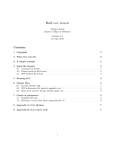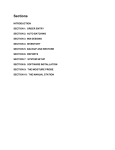Download SERVICE MANUAL
Transcript
CUSTOMER ____________________________________________ TAG No. ________________________________________________ P.O. No. ________________________________________________ ROTOSTAT MIXER MODEL ________________________________ ADMIX JOB No. __________________________________________ SERIAL No. _____________________________________________ DATE ___________________________________________________ SERVICE MANUAL TABLE OF CONTENTS Section Page No. Section Page No. SECTION 1 SECTION 8 UNCRATING & INSPECTION ............................................... 3 CLEANING ............................................................................ 9 SECTION 2 SECTION 9 INSTALLATION & PRE-OPERATION CHECKOUT .............. 3 BEFORE STARTING THE MIXER! ....................................... 3 MIXER POSITIONING .......................................................... 3 MAINTENANCE .................................................................... 9 SECTION 10 LUBRICATION ...................................................................... 9 SECTION 3 MOTOR CONNECTIONS AND WIRING ............................... 4 SECTION 11 SECTION 4 DISASSEMBLY & REASSEMBLY OF BEARING STAND ............................................................... 10 ASSEMBLING MIXER SHAFT COUPLING .......................... 4 SECTION 12 SECTION 5 SHAFT STRAIGHTENING PROCEDURE ............................ 5 OPTIONAL SEAL PLATE REMOVAL ................................. 12 OPTIONAL SEAL PLATE INSTALLATION ......................... 12 SECTION 6 SECTION 13 DISMANTLlNG MIXER HEAD ............................................... 6 REASSEMBLlNG MIXER HEAD ........................................... 6 REPLACING WORN BUSHINGS .......................................... 6 REPLACING USDA PARTS .................................................. 8 HOW TO MONITOR BUSHING WEAR ................................. 8 OPTIONAL JETFOIL™ ....................................................... 13 SECTION 14 PARTS LIST ........................................................................ 14 SECTION 15 SECTION 7 OPERATING THE MIXER ..................................................... 9 MAINTENANCE AND TROUBLESHOOTlNG CHECKLIST ................................... 15 GENERAL INFORMATION With proper care this ROTOSTAT Mixer will give years of trouble-free service. If you should have any questions regarding its operation which are not answered in this manual, call the Admix factory at: 1-800-466-2369 CAUTION The mixing head must not be run without being submerged in liquid. It must be entirely below liquid level during rotation. If it runs dry---or partly dry---the stator bushings, the washers and the rotor shaft will be exposed to excessive wear. CAUTION Prior to connecting the electric motor to the power supply, remove the prop and the mixing head! (See instructions) If the mixer shaft is threaded and the direction of rotation is wrong, the rotation of the drive unit might unscrew the mixer prop which could cause damage to the prop or vessel. THE PROPER ROTATION IS CLOCKWISE, WHEN SEEN FROM ABOVE, indicated by the arrow on the bearing stand. page 2 SECTION 1 UNCRATING & INSPECTION 1-1 After uncrating your mixer, check for shipping damage and report any damage immediately to the carrier and to ADMIX. Please make sure that all parts are accounted for. 1-2 The mixer is normally shipped totally preassembled if in-tank couplings are not used. If the unit has a coupling, the shaft may be in a separate container. Do not remove protective wrappings, if the mixer is to be stored before it is placed in operation. Store the mixer in a clean, dry location. SECTION 2 INSTALLATION & PRE-OPERATING CHECKOUT 2-1 Moving & mounting mixer • Lift mixing unit from the BEARING STAND ONLY. DO NOT LIFT OR CARRY FROM THE SHAFT as this could cause the shaft to bend and may lead to excessive vibration or damage. • Mixer may be installed vertically or slightly inclined (5-10 degrees) for proper operation. • If clamp mounted, be sure the clamp is secured to the vessel and mixer properly. • The ROTOSTAT Mixer MUST BE FIXED SECURELY TO A MOUNTING PLATE OR FLANGE, and cannot be suspended on hooks or straps or any other non-fixed device. Mixing Head Assembly Rotation STATOR broke away to view ROTOR BEFORE STARTING THE MIXER 2-2 Rotation, & Check list • Check the rotation of the ROTOR within the STATOR. Rotation direction arrows pointing clockwise must be visible from above! • Check to insure that the STATOR rotates freely, separate from the shaft by holding the shaft and spinning the STATOR by hand. • Run through the complete check list on page 15 before starting mixer STATOR ROTOR See illustration 3 or 4 for more details MIXER POSITIONING 2-3 For liquid-liquid, non-vortex conditions • The ROTOSTAT mixer will operate satisfactorily in most cylindrical vessels, with full hemispherical bottoms providing the best flow pattern. Vessels can also be conical or dished. Vessels should be selected with the smallest diameter and greatest depth provided that shaft length limits are not exceeded. • The best mixing is obtained at vertical, off-center positioning, from approximately 3 to 4 inches off-center to ¼ of the tank diameter (from the tank wall) in larger vessels. Where permissible, baffles are recommended in the vicinity of the mixing head, or up to normal operating level. Either 2 or 4 Baffles are advised, with a width of T÷12, and mounted a distance of T÷72 off the tank wall (where T= Tank diameter). 2-4 For liquid-solid, vortex conditions • If vortex is required (for instance, to draw down light, powdered materials), place the mixing head in the center of the vessel, vertically or slightly inclined, without baffles. • The VORTEX SHOULD NEVER BE SO BIG THAT THE MIXING HEAD RUNS DRY OR PARTLY DRY. Should the vortex extend to the head, move the mixing head a few inches off vessel center and the stator bushings will be lubricated by the mixing medium. By this means, cavitation, and thereby heavy wear is avoided. 2-5 Mixing head location • The recommended location of the mixing head is approximately ½ of the Rotor diameter (or 3 to 4 inches off bottom) for Models X. Model XP, with the lower propeller should be 1 prop diameter off bottom. • When a stronger vortex is required, the mixing head may be installed as high on the turned down portion of the shaft as possible, provided the head is not directly center mounted and the vortex does not extend down to the rotor/stator. page 3 SECTION 3 MOTOR CONNECTIONS AND WIRING CAUTION Motor must be installed in accordance with NEMA and all applicable federal state and local electrical codes. Interlocks should be installed on all personnel access stations to prevent injury during internal tank maintenance. 3-1 Prior to connecting the motor and checking the direction of rotation, remove the mixing head and Prop from the shaft. (See instructions) Connect via an overload protection device and check the direction or rotation which must be clockwise, seen from above (indicated by the arrow on the bearing casing). When the mixing head is remounted - Do not start the mixer unless the mixing head is submerged in liquid. SECTION 4 ASSEMBLING MIXER SHAFT COUPLING 4-1 IMPORTANT - If the shaft has been shipped NOT attached to the mixer, the shaft has bolted coupling halves. Please carefully review the following procedures before installing or assembling the shaft: • IMPORTANT - Before bolting coupling halves together, be certain to align the match marks on each half. The shaft has been straightened to provide minimal shaft run out when match marks are aligned. • Make sure that the shaft coupling bolts (#1) and retaining bolt (#4) are tight and that the spring washers (#2) and retaining plate (#3) are in place PRIOR TO STARTING THE MIXER BEFORE EACH AND EVERY USE. 1 • Bolted couplings are furnished with the proper number and size of bolts. Tighten with standard torque procedures making sure that the registers on each half provide a tight connection. The upper coupling half (#6) is a tapered design with a retaining plate (#3) and bolt (#4) to insure absolute alignment and prevent loosening (see illustration #1). The lower coupling half (#5) is welded directly to the shaft and does not require adjusting. 6 4-2 Reassembly of tapered half couplings. • Should it be necessary to remove the tapered upper coupling half, it will be necessary to EXERCISE EXTREME CARE ON REASSEMBLlNG THE COUPLING. It is advisable that a substance such as blueing be applied to check the accuracy of the taper fit. It must be completely seated to allow realignment of the shaft. BLUEING MUST BE REMOVED PRIOR 2 TO FINAL ASSEMBLY. • After the two coupling halves are aligned and rebolted, it is necessary to check the shaft run out to insure that the TIR (Total Indicator Runout) does not exceed .004" at any point along the shaft. page 4 3 4 5 ILLUSTRATION No. 1 MIXER COUPLING SECTION 5 NOTE: All mixers are shipped with shafts straightened to less than .004” runout. Should the shaft develop excessive runout, vibration or wobble from wear and tear, the shaft may be straightened by the following dure: proce- SHAFT STRAIGHTENING PROCEDURE (see illustration #2) 5-1 Mount ROTOSTAT so that the shaft is in the vertical position and free to rotate by hand. 5-2 Clamp dial indicator to a rigid support that can be slid up and down the length of the shaft in 8"-12" increments. 5-3 For 2 F/D Coupled Shafts Only: Remove shaft and lower coupling half. Indicate the face of the upper coupling half, this face must be perpendicular with drive shaft to within .002" before continuing with shaft straightening. 5-4 For 2 F/D Shafts Only: Reinstall shaft and lower coupling half in each of the four (4) possible positions indicating on the lower end of the shaft in each position. Install bolts and torque in the position having the least amount of runout. 5-5 For 2 F/F and 2 F/D Shafts: Indicate shaft at a point 8"-12" from lower flange*. Mark this point “A”. Rotate shaft to find the point having the greatest amount of runout. Mark this point with a vertical mark. If the runout at this point is .004" or less, go to step #5-6. If it is more than .004", go to step #5-5A. *On 2 F/F units or from coupling on 2 F/D. 5-5A With a pinpoint, high heat flame, heat a point 180º from the vertical line and as close to couplings (on 2 F/D units) or flange (on 2 F/F units) as possible without burning the v-ring or seal. Heating point should be no larger than 1/4" diameter. Shaft diameter will determine the amount of time the flame will be held on the shaft. -On shafts ranging from 1" - 1½”, 3-5 seconds will normally pull .005-.010" out of the bend. 5-5B After heating, immediately quench only the heated spot with an ice cold wet rag. Cool the rag off every 15-30 seconds and continue to hold on heated spot until all heat has been pulled from shaft. Too much heat will yield inconsistent results. 5-5C Rotate shaft to recheck runout at point “A”. If runout is still over .004", repeat steps 5-5, 5-5A and 5-5B 1" closer to point “A” from last heating point. Continue repeating these steps until runout is .004" or less. 5-6 Move indicator to a point 8"-12" from point “A”, label this point “B”. Rotate shaft to check runout at point “B”. Point “A” is now the point to apply heat. Repeat steps 5-5A, 5-5B and 5-5C until runout at point “B” is a maximum of .004". 5-7 Continue moving down the shaft through points “C”, “D”, “E”, etc. until there is no point on the shaft with runout any greater than .004". point point A point B C point point ILLUSTRATION No. 2 E D point If indicator reads more than .004” at this point, place heat 180 deg. from high point and to point A. F page 5 SECTION 6 DISMANTLlNG MIXING HEAD STYLE XP AND X Review illustration #3 before proceeding. 6-1 If the unit has a propeller (XP models), twist the prop counterclockwise to unthread. 6-2 Loosen screw (hex head on USDA units, socket head on non-USDA units) in the lower stop collar (#1) and pull the lower sleeve (#2) and lower washer (#3) off the shaft. Loosen the screw (hex head on USDA units, socket head on non-USDA units) in the rotor (#5) and upper collar (#10). All of the components should now easily slide off. Upper and lower sets of stop collars, washers and sleeves are identical and may be interchanged. Occasionally, a rotor or collar may gall on the shaft. Tap the component with a mallet until the parts moves freely. DO NOT USE EXCESSIVE FORCE IN REMOVING THE PARTS! REASSEMBLlNG MIXING HEAD STYLE XP AND X 6-2 Place upper stop collar (#10) upper sleeve (#9) and upper washer (#8) on the mixer shaft. Insert rotor (#5) in stator (#6). Place stator (with bushings installed) and rotor on the mixer shaft with the arrow embossed on the rotor pointing to the direction of rotation. Place lower washer (#3) lower sleeve (#2) and lower stop collar (#1) on the shaft. Tighten the lower stop collar to prevent the mixing head from dropping. Place rotor (#5) in desired position on the shaft and tighten screw(s) (hex head on USDA units, socket head on non-USDA units) securely. (In order to give access to screws, you may move the stator a little upwards). Undo the lower stop collar (#1) and adjust the position of the stator so that the rotor is positioned inside the slotted stator rim. Tighten the lower stop collar screw securely. Position the upper stop collar (#10) 1 to 3 mm above the upper sleeve (#9) and tighten securely. It is very important for the stator to be able to revolve absolutely freely on the shaft. If the upper washer, sleeve and collar are too close to the top of the stator, the stator may not be able to revolve freely and the motor may become overloaded. Rethread the prop if style XP. REPLACING WORN OR DAMAGED BUSHINGS STYLE XP AND X 6-3 Bushing wear should be checked after every 100 hours of service or once per month, minimum. As the bushings, shaft or shaft wear sleeve show any deterioration, we recommend immediate replacement of the bushings (and possibly the wear sleeve if supplied with one). Bushings are available in Teflon, Rulon, Bronze, or stainless reinforced Teflon. Ceramic bushings have integral washers and will therefore appear different (see illustration #3). 6-4 When replacing Bronze, Teflon, Rulon or stainless steel reinforced Teflon, the new bushing can be easily press fit into the stator. Ceramic bushings require an interference fit of .001" to .0015". This is best accomplished by heating an oil bath to 400°F and dropping in the stator for 10 to 20 seconds. Upon removing the stator from the bath, the bushing should now be easily pressed into the stator. DO NOT HAMMER OR POUND THE BUSHING INTO THE STATOR as this will surely damage or destroy the bushing. page 6 10 9 8 XP Heads only 7 6 5 4 11 3 2 1 XP Heads only SPECIAL SLEEVE DESIGN FOR CERAMIC OR OTHER HARDENED SURFACE MATERIAL STANDARD X AND XP MIXING HEADS WITH 316SS SLEEVE ILLUSTRATION No. 3 page 7 XP Heads only REPLACING USDA PARTS 6-5 If the ROTOSTAT is supplied in a USDA approved version, the bushings, washers and hardware are different from the standard model. All USDA models feature Rulon or PTFE bushings with an integral washer (see item #1 on illustration #4). The hardware to install the rotor and the stator collars are supplied with hex head 3 bolts (#2) with Teflon washers (#3) to seal the threads (see illustration). When disassembling or reassembling the USDA mixing head be sure to utilize only the integral bushing/washer components 2 and the hex bolts with Teflon seals. Non food-grade materials and or set screws are strictly prohibited by the USDA. 1 4 5 7 ILLUSTRATION No. 4 USDA MODIFICATIONS 3 6 4 8 2 3 1 9 XP Heads only HOW TO MONITOR BUSHING AND SLEEVE WEAR 6-6 The initial gap or clearance between the rotor and stator can vary from .020 to 040. We recommend the use of a feeler gauge to check the initial gap between the rotor and stator. As the bushing (or wear sleeve) wears the gap will increase. The gap should not be allowed to go beyond .080", as this could cause the bushing and mixing head to fail. The feeler gauge should be used to insure problem-free operation. page 8 SECTION 7 OPERATING THE MIXER 7-1 ROTOSTAT Mixers are designed to operate intermittently under all standard conditions and at normal levels. It is not good practice, however, to operate continuously when extreme vortexing or surging occur. All high speed mixers operate at high temperatures and therefore may feel hot to touch. (Max. bearing frame temp.: 160°F) 7-2 After mixer has been securely fastened in position and a check of Mixing Head rotation and clearance has been achieved, mixer is ready for operation. 7-3 Turn on the mixer. Allow time enough for the mixing pattern to be established, then make any required adjustment of baffles. 7-4 At the end of two weeks service, check all mounting screws for tightness. SECTION 8 CLEANING Clean the mixing head after use by letting it spin a few minutes in hot water or a suitable cleaning solution. Remnants of dried material may cause blocking of the stator which will result in overload of the motor, so proper cleaning should always be carried out immediately after use. SECTION 9 MAINTENANCE The condition of the stator bushings and washers should be regularly checked. The easiest way to check the stator bushings is to grasp one of the stator blades and check if any considerable radial slackness can be verified. If slackness occurs, the stator bushings should be replaced as soon as possible, and in any case, before the slackness becomes so critical that the high speed rotor could touch the stator rim. (See section 6-6) LUBRICATION SECTION 10 ____ Required (Only on large mixers) ____ Not Required (Most models are supplied with sealed, pre-packed bearings) Lubrication of the high speed bearings is generally not required. If necessary, please proceed as below: The two ball bearings inside the bearing case should be lubricated with heat proof, high pressure lubrication grease after every 500 hours operation. Quantity of grease: about 1.7 fluid ounces (50 cm3) for each bearing. page 9 SECTION 11 DISASSEMBLY & REASSEMBLY OF THE BEARINGSTAND 1 See illustration #5 2 11-1 Remove the Coupling Half, V Ring and Stainless Cladding If the shaft has couplings, the upper coupling is removable and can be disassembled by following instructions within section 4. After removal of the coupling half, slide the rubber V ring (#18) down off the shaft. The stainless cladding (#15) will pop off. Save both the V ring and cladding for reassembly. 6 4 3 5 11-2 Remove the motor. Remove the 4 bolts (or 8 on large units) at the motor flange. If the motor will not readily separate from the motor flange (due to a seized key, coupling or rust), we recommend inserting a wedge between the motor flange and bearing stand to pry them separate. Alternately, the motor may be driven out by inserting long undersized bolts in the threads and tapping on them, being careful not to damage the threads or the bolts. 9 7 10 8 11 12 11-3 Remove the upper snap rings. There are two (2) snap rings on the upper bearing stand (see illustration) one on the O.D. of the coupling (#6) and one on the I.D. of the bearing stand (#4). Remove both. Larger units may have a bearing cover which must be removed prior to pulling the snap rings. 13 15 14 16 17 18 19 ILLUSTRATION No. 5 BEARING STAND page 10 Double bearings on size 200 & larger frames 11-4 Drive the shaft out. Place the mixer horizontally on a bench or on the floor. With the coupling removed below the mounting flange, it should be possible to tap the shaft out of the motor side from the bottom. Place a wood block or other device over the shaft to protect - tapping the shaft directly could cause run out problems if kinked. In order to not bend the shaft, it is important that you swing the hammer completely parallel with the shaft and hit the center of the shaft end only. One or two blows should be sufficient to loosen the shaft - followed by several taps to finish driving the shaft out. The upper bearing (#5) will pop out as the shaft slides out of the bearing stand. The motor coupling (#7) will also come out with the snap ring (#3) below the bearing still attached to it. This snap ring (#3) may need replacing if damaged. The lower bearing (#12) will remain in place in the bearing stand. 11-5 Remove the Lower Bearings Remove the radial seal (#17) and seal ring (#16). Remove the snap ring (#13) to expose the bearing and retaining ring. The lower bearing can now be removed from the bottom by using a long drift or rod to drive out from the top end. 11-6 Reassembly. Reassemble the bearing stand in reverse order. Be sure that all internal surfaces in the bearing stand are cleaned prior to reassembly. Be sure to apply a generous amount of grease between the lower bearing and the seal to insure lubrication. It may be necessary to apply Loctite or a similar compound at the bearing to prevent movement. The seal ring (#16) may also require a sealant to hold it in place. The seal ring is either stainless steel with o’rings or PVC. Continue reinstallation of the upper bearing, snap rings and motor as above. page 11 SECTION 12 OPTIONAL SEAL PLATE SEAL PLATE REMOVAL (See illustration #6) 12-1 12-2 12-3 12-4 Carefully remove mixer assembly from tank. Remove mixing head, from lower shaft - see section 6 Remove lower shaft from mixing unit & tapered bore upper coupling half (2F/D model only)- see section 4 Check shaft (#4) for surface marks that could damage seal lip (#1) during removal, and remove burrs, clean as needed, and apply a light lubrication film on shaft to aid seal removal. 12-5 Remove seal plate mounting bolts (# 5). and carefully slide seal plate (#2) off shaft. 12-6 Inspect seal (#1) for wear and or damage, and replace if required. Item #3, Bearing frame ILLUSTRATION No. 6 Item #5, Hex head bolts Item #1 Item #2, Seal plate/Mounting flange Item #1, Seal mounting position B Seal mounting position A (CIP seal) (back-up grease seal) Item #4, Mixer output shaft Standard seal plate shown. - Optional 150 lb. ASME flange or Tri-Clamp flange may also be used. SEAL PLATE INSTALLATION (See illustration #6) 12-7 Complete steps 12-1 through 12-3 for new SEAL PLATE assembly installation. For replacing worn seal only: make note of old seal (#1) position in flange (Position A or Position B), and install new seal (#1) in the same position. 12-8 Check shaft (#4) for surface marks that could damage seal lip (#1) during installation, and remove burs, clean as needed, and apply a light lubrication film on shaft to aid seal installation. 12-9 Carefully slide seal plate (#2) on shaft. 12-10 Position the seal plate (#2) on the mixer bearing frame (#3) mounting flange, and carefully center it relative to the seal (#1) and shaft (#4) to within .005” T.I.R. 12-11 Install seal plate mounting bolts (# 5), and recheck seal for position (per 12-10) after bolts (#5) have been tightened. 12-12 Reinstall lower shaft (2F/D models only) - see section 4. Check shaft straightness - see section 5. Reinstall mixing head - see section 6 and review sections 7, & 9. page 12 SECTION 13 OPTIONAL JETFOIL™ IMPELLER JETFOIL™ MOUNTING (See illustration #7) 13-1 The JETFOIL™ (#1) must not be mounted upside-down. See illustration #7 for proper orientation. 13-2 The JETFOIL™ (#1) should be located 6 to 8 inches below liquid level. 13-3 After positioning the JETFOIL™ (#1) on the shaft (#2) tighten the two set screws (hex head bolts with Teflon washers on USDA models) (#3). ILLUSTRATION No. 7 Liquid level 6” to 8” Item #2, Mixer output shaft Item #1, JETFOIL™ Item #3, Set Screws, (2) Adjustable Standard JETFOIL™ mounting position. page 13 PLEASE CALL 1-800-466-2369 TO ORDER PARTS OR RECEIVE A CURRENT PRICED PARTS LIST VIA FAX. SECTION 14 TYPICAL PARTS LIST • All Rotostat Models utilize the components listed. • Current priced parts lists are sent under separate cover within one week of shipment. • These parts lists shown here may be used as a guide. Reference numbers relate to the illustrations in this manual only. Note: Mixing Head Components may be Slightly Different with Special Designs Non-USDA X & XP Mixing Head Parts - illustration #3 REF. NO. DESCRIPTION DETACHABLE SHAFT COUPLING - illustration #1 REF. NO. DESCRIPTION Qty. per Unit Recommend for Stock 1 Coupling Bolts 4 -- 2 Spring Washers 4 -- 3 Retaining Plate 1 -- 4 Retaining Bolt 1 -- Qty. per Unit Recommend for Stock 5 Lower Welded Coupling 1 -- 6 Upper Taper Bore Removable Coupling 1 -- 1 Lower Stop Collar with Screw 1 -- 2 Lower Wear Sleeve 1 1 3 Lower Washer 1 1 REF. NO. 4 Lower Bushing 1 1 1 5 Rotor with Screw 1 -- 6 Stator 1 7 Upper Bushing 8 BEARING STAND PARTS - illustration #5 Qty. per Unit Recommend for Stock Motor 1 -- 2 Key for Motor 1 -- -- 3 Snap Ring (Below Upper Bearing) 1 1 1 1 4 Snap Ring (Above Upper Bearing) 1 1 Upper Washer 1 1 5 Upper Bearing (Double Bearing on 200 Frame and Larger) 1(2) 1 9 Upper Wear Sleeve 1 1 6 Snap Ring / Motor Coupling 1 1 10 Upper Stop Collar with Screw 1 -- 7 Motor Coupling 1 -- 11 Lower Detachable Prop 1 -- 8 Bearing Stand Housing 1 -- USDA X & XP Mixing Head Parts - illustration #4 9 Pin 1 -- REF. NO. DESCRIPTION DESCRIPTION Qty. per Unit Recommend for Stock 10 Drive Shaft 1 - 1 Upper & Lower Stop Collars 2 -- 11 Bearing Ring 1 -- 2 Hex Head Bolt (For Stop Collars) 2 -- 12 Lower Bearing 1 1 3 Teflon Washer / O-ring 4 2 13 Snap Ring (Below Lower Bearing) 1 1 4 USDA Rulon or Teflon Bushing / Washer 2 2 14 Dismantling Screw (Not on All Units) 1 -- 5 USDA Rotor 1 -- 15 Flange Cover (SS) 1 -- 6 Stator 1 -- 16 O'Ring 1 1 7 Hex Head Bolt (For Rotor) 2 -- 17 Radial Shaft Seal 1 1 8 Teflon Washer (To Seal Prop Thread) 1 1 18 V-Ring Excluder 1 1 9 J-Style Prop 1 -- 19 Seal Retainer (SS) 1 1 page 14 SECTION 15 MAINTENANCE AND TROUBLESHOOTING CHECKLIST Before starting mixer check the following: 1. Mixing head is submerged. ........................................................................... _____ 2. Rotation of shaft is clockwise when viewed from above. .............................. _____ 5. Baffles are installed as recommended. (If required) ..................................... _____ 6. If shaft is coupled, coupling halves are installed with match marks aligned..................................................................................... _____ 7. All hardware on couplings is tightened, washers are in place. ..................... _____ 8. Initial gap between rotor and stator checked with feeler gauge and recorded here: _________ ........................................................................... _____ 9. Bolts securing rotor and stator collars checked for tightness. ....................... _____ 10. Check run out to insure that it does not exceed .004" at any point. .............. _____ Check during operation: 1. Mixer is not vibrating on mounting stand. ..................................................... _____ 2. Shaft is turning smoothly without warble or deflection. ................................. _____ 3. Bearings are quiet and bearing stand is warm to the touch - NOT excessively hot (over 150°F). ....................................................................... _____ 4. All hardware checked for tightness periodically. ........................................... _____ 5. Gap between bushing and stator monitored for wear periodically. ............... _____ 6. Liquid in vessel is not exhibiting extreme vortexing, i.e., the head is still submerged. ......................................................................................... _____ page 15















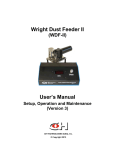
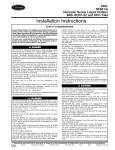
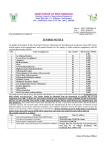
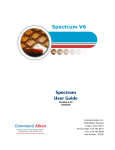
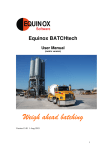
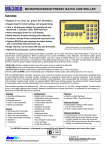
![Compression Test Machine Automation [CTM]](http://vs1.manualzilla.com/store/data/005689373_1-fbebbd60727252c31d96e8e1d4d5f20d-150x150.png)
